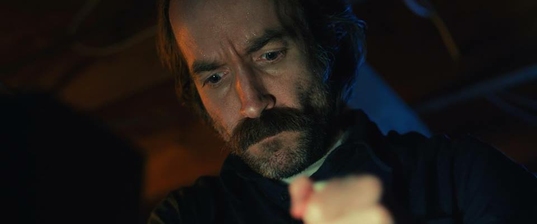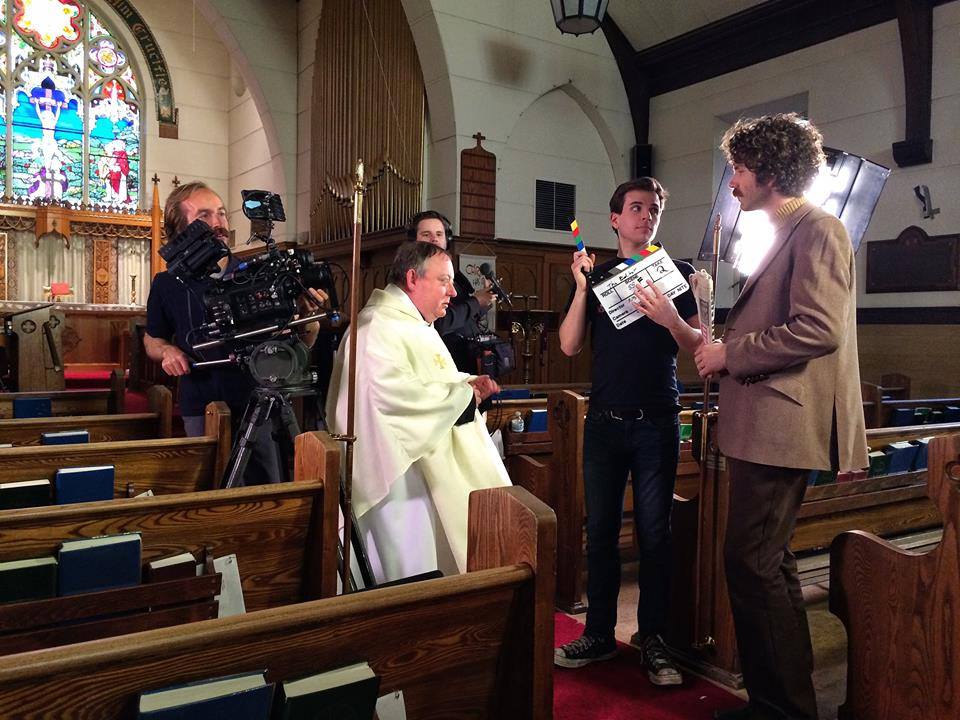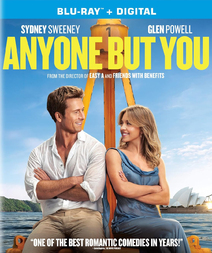
Interview: Adam Brooks, co-writer, co-director and star of Astron 6's The Editor
Filed under: Interviews

Every now and then, a small independent film manages to break through the cracks in the towering wall of entertainment available to our fickle culture. Like some little engine that could, it attracts critical praise and audience attention through its sheer brilliance, and without some huge marketing campaign. I hope this is the case for Astron 6's The Editor.
It's a classic on the cusp of finding an audience, a frenzied and breathtaking homage to the Italian giallo thrillers of the 70s and 80s. That's right: we're talking wonky dubbing, macho Italian accents, exposed flesh and plenty of it. It's everything you could ask for in a horror movie: it's funny, scary, bloody, and terrifically entertaining.
For those unaware, Astron 6 is a team of five Canadian low-budget filmmakers, whose work crisscrosses the horror/comedy/cult/exploitation genres: Adam Brooks, Matthew Kennedy, Steven Kostanski, Conor Sweeney and Jeremy Gillespie. They are the twisted minds behind recent cult faves, ManBorg and Father's Day, the latter of which was released by the iconic Troma Entertainment. It's been a long journey for Astron 6. These guys toil, sweat, and bleed for their movies and their newest, The Editor, is no different.
The idea for the film first came to Brooks while he was editing, of all things, a wedding video. The plot follows a film editor named Rey Ciso (Brooks, who also co-writes and co-directs with Kennedy and Sweeney) who slowly descends into madness after becoming ensnared in a series of bizarre murders. The film is arguably the most mature, confident work from Astron 6, a group of filmmakers whose beginnings were as humble as any.
Tony Hinds: I understand that the team at Astron 6 first came together around the Winnipeg Short Film Massacre festival in the late 2000's. For those readers not in the know, who/ what is Astron 6, and how did the collective come about?
.jpg)
Adam Brooks: After three or four years of competing against each other at the Winnipeg Short Film Massacre, we decided to join forces in 2007, combine our strengths and make films as a collective. Those were simpler times. We all lived in Winnipeg, and hung out a lot. Today, Steven Kostanski and Jeremy Gillespie work on big time films in Toronto, (Matthew Kennedy) and (Conor Sweeney) live in Kenora, and I live in Winnipeg.
TH: What came first...? The idea to make a giallo film, or the idea to tell a story about an editor?
AB: This time the idea of the editor losing his mind came first, and then we decided it might be fun to turn it into a giallo.
TH: How did the project develop?
AB: We started shooting The Editor on SLR as a fake trailer, making it up as we went along. It was fun, and we'd done similar things making the fake Father's Day and Fireman trailers. But just like Father's Day, when we finally wrote the script we had to write around the pieces we'd already shot, which is no fun at all, and no way to write a script, let me tell you. Luckily our script won us a grant from Telefilm Canada, and we decided to start shooting the whole thing over again on a RED camera.
TH: How early in the writing process did you have that brilliant final image?
AB: Very early.
TH: If The Editor spawns some new giallo fans, as I believe it will, where should the giallo virgins look first? Do you have a Top 5 essential giallo films?
AB: I would recommend Don't Torture a Duckling, Suspiria, Tenebre, Opera, and even though it's not technically a giallo, The Beyond. I like the absurdity and style of those films. They would be in good company with the work of Luis Bunuel or David Lynch.
TH: Suspiria seems to generally be considered the ultimate giallo film. There has been talk of a remake in recent months. What are your thoughts on the remake? Would Astron 6 be interested in stepping up to the plate, if given the chance?
AB: I'm generally against remakes outside of The Fly and The Thing but I am very much for being paid. So if it was a paid gig, I think A6 would be up for it.
TH: Which horror films have you enjoyed/loved from the last few years?
AB: What We Do in the Shadows and Nightcrawler were my favourite films of the last year... both horror-ish, both funny.
TH: The attention to detail in The Editor is fantastic! What can you tell us about some of the horror/thriller film references? Also: Was I wrong to assume the movie references both Klute and Don't Look Now?
AB: A lot of the references are just very self-serving for us as film fans - we get to recreate bits from movies we love, and be inside them... who wouldn't want to do that? And it's a little bit of added fun for those viewers who have seen these rare gems. I took a lot of screen-grabs from Klute and Don't Look Now to keep on hand for lighting references but can't say that there is a very specific reference to either in the film. Porfiry is obviously physically modeled on Donald Sutherland, and I know the scene where he breaks into the asylum is similar to a scene where Sutherland breaks into a building in Klute but we weren't going for a clear reference as we so often did with movies like The Strange Vice of Mrs Wardh, Hitch-Hike, The Beyond, Death Wears High Heels, Tenebre, etc.
TH: It's fantastic to see such a wonderfully cinema-literate piece of work that also manages to prove so consistently funny. The tone of comedy that you guys pull off in The Editor is so specific. When did you know that this tonal experiment was working? I can only imagine that seeing your opening scene with Bella in the editing room, with the dubbing and music for the first time... the level of funny that scene hits must have jumped tenfold after the sound elements were added.
AB: You're right that it got funnier to us once the foley was added. So much of the dialogue is about the stilted cadence of the Italian films of the 70's. It was a product of Italian writing being translated into English and then performed by Italians, and then finally dubbed by English actors trying to stay in sync with the mouths on screen. We would try to talk in that very unnatural way on set.

TH: Did the conceptual nature of the film help with the editing? I imagine the fact that it's supposed to seem dubbed would take some pressure off the actual on-set photography of a scene... knowing that you'll be able to tinker and find the perfect line delivery in editing with ease. How much of the film is dubbed VS. actual on-set sound?
AB: The film is completely dubbed, except for the scenes with our big name actors Paz De La Huerta, Laurence Harvey and Udo Kier, who we couldn't afford to have back for looping. Editing a movie with no audio guide track is really, really hard. It's hard to create any kind of rhythm when you don't know exactly what is being said where, and it made for lot of headaches trying to remember improvised lines.
TH: To avoid spoilers, I'll be careful how I ask this next question... was the trenchcoat clad killer always played by the same person in every scene?
AB: I would like to say yes, but no, various people played the part for various mundane reasons.
TH: In classic giallo films, the music is one of the most essential elements. But in bad giallo, that music can sometimes be distracting. The Editor wonderfully sidesteps this problem with a stunning score. It perfectly supports the tone of every scene. But I was surprised to see as many as seven different contributors to the soundtrack. What can you tell us about the music of The Editor?
AB: I can tell you we got the very musicians I can imagine for the project. It's a real dream-team. And I agree, that it's incredible that all their music works so well together -- even more incredible if you realize none of them heard what the others were doing. We just directed them each individually and gave them all the same reference materials.
TH: While the horror references may get the most attention, it's impossible to make such a consistently funny comedy, regardless of genre elements, without having a vast knowledge of comedy itself. You guys clearly know funny as well as you do scary. Along the same lines of the horror classics that influenced The Editor, what are some of your comedic influences?
AB: Stella, The Kids in the Hall, the Zucker Brothers, and anything that feels dangerous or edgy.
TH: The macho, Italian-ness of it all is so perfectly handled. Your performance is so charming, endearing and diverse. Even the way that Rey can't bring himself to check out Bella's butt due to sheer self-loathing... is simultaneously funny and sadly moving! Rey isn't merely a sketch-comedy character, though you do nail the comedic beats. From the opening scene, Rey is a real guy with real emotions, despite the surreal world he inhabits. Do you have a favorite Italian actor, or a specific one in mind who inspired the character of Rey?
AB: My favourite Italian actor is Franco Nero, and I shamelessly tried to steal his appearance and some of his affectations for this film. If I could have changed my bone structure and hairline, I would have.
.jpg)
TH: The widescreen cinematography is really lush, colorful and beautiful. You mentioned that you shot the film with the RED camera. How did you find it? I can only assume you're happy with the results. You can pause Suspiria at almost any moment and the composition will always be beautiful. The same compliment could be given to The Editor. And I do give it! Even just that still image of Bella with the hand that is being used in the marketing material is gorgeous.
AB: That's very kind of you to say. This was our first time working with RED, and I find it a big step up from DSLR - though we were using only DSLR lenses on our RED because we couldn't afford to even rent RED lenses. Italy has a great tradition of beautifully photographed films, even cheap genre films. Suspiria and The Fifth Cord are like candy for the eyes, and both far better looking than anything we could come up with, but they were something to aim for and inevitably fall short of.
TH: Paz De La Huerta is so deliriously over the top. If she found a time machine, she could go back and get hired by 70s Argento in a second! How much of that was directed/ scripted and how much was her contribution?
AB: That was pretty much all her. It was massaged in editing, but not on set.
TH: The entire cast is terrific. How much fun were Laurence Harvey and Udo Kier to work with? Getting to direct two cinematic icons like that must have surely been intimidating and surreal, but I would just never be able to stop smiling if I was in the same room as those guys. It must have been a blast!
.jpg)
AB: It was an absolute blast, you're right. And I don't think I was able to stop smiling while on set with them. They were both very cool, easy-going, low-maintenance actors who were full of great ideas, and unwavering energy. They're both so watchable that they elevate the material. As a director, I would be watching the monitor thinking, "this is a real movie," excited to see what happened next. Udo has been in virtually every movie ever made, and he's always amazing. Udo was encouraging to us when we were at our lowest point: out of money, with 80% of the movie left to make. He is one of the best people I've ever met. Laurence, I had only seen in The Human Centipede 2. But I'd met at Texas Frightmare Weekend, and I knew immediately that I wanted to cast him in a completely different kind of role.
TH: Do you regret that Matthew got to have all the scenes with Harvey and Kier?
AB: Yes. Technically I'm on camera with both of them once though... and I got to be on screen with two of my heroes -- Dan Bern and John Paizs -- which was thrilling. Even though their cameos are brief, they're very meaningful.
TH: What was the most important lesson you guys learned on Father's Day and ManBorg that you wanted to keep in mind while making The Editor?
AB: Don't give your movie away for nothing.
TH: May I ask, could you elaborate on what you mean when you say that? I ask because you mentioned that online movie piracy is hurting the business at the end of the "making of" doc.
AB: The piracy is awful but inevitable. I was speaking more to making deals with unscrupulous distributors and/or sales agents, of which there are many.
TH: Before we wrap up, I'm embarrassed to admit I was unable to place what/whom the film in which the man climbs a tree and screams, "I want a woman!" was referencing. Does that filmmaker have a real life doppelganger? Did I drop the movie-geek ball on this one?
AB: You did. It happens in Fellini's Amarcord and it was Udo's idea. We try to make it seem like it happens in the fictional film-within-a-film, The Mirror and the Guillotine by Umberto Fantori, who is sort of modeled on Fellini.
TH: Amarcord! Of course. I was almost thinking it was like early Franco Brusati. In my defense, I'm more of a La Dolce Vita/Satyricon kind of guy. Will you and Matthew continue directing together? I know it may be early, but I'm already eagerly anticipating your next film.
AB: I hope so. We don't know what will be next. It's always a struggle to figure out the money, and that pretty much decides the rest.
The Editor debuts in Astron 6's hometown of Winnipeg on August 20 at Cinematheque, and on DVD/Blu-ray on September 8.
BTS photo credit to S. Kennedy. All images supplied.
Tags: The Editor, Adam Brooks, horror, Udo Kier, Laurence Harvey, Matthew Kennedy, Conor Sweeney, Astron 6, ManBorg, Father's Day
Related Posts
- Detecting the Marvelous - Sandman Preludes & Nocturnes - Sweet Dreams Are Made Of These
- Review: The Editor
- Review: Da Sweet Blood of Jesus
- Review: Unfriended
- Top Fives: Weird Horror Movies
Tony Hinds is a Canadian writer who studied film at the University of Winnipeg. In addition to ShowbizMonkeys.com, Tony has reviewed films for Step On Magazine and The Uniter. You can find Tony on Twitter.


SBM on Social Media